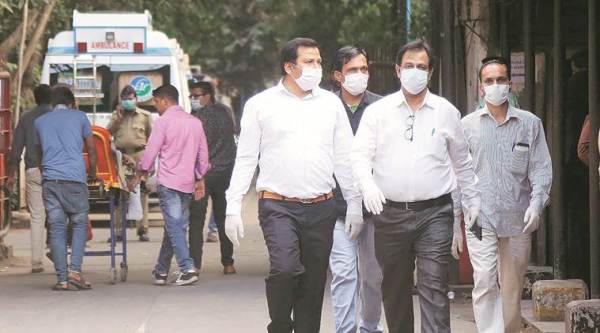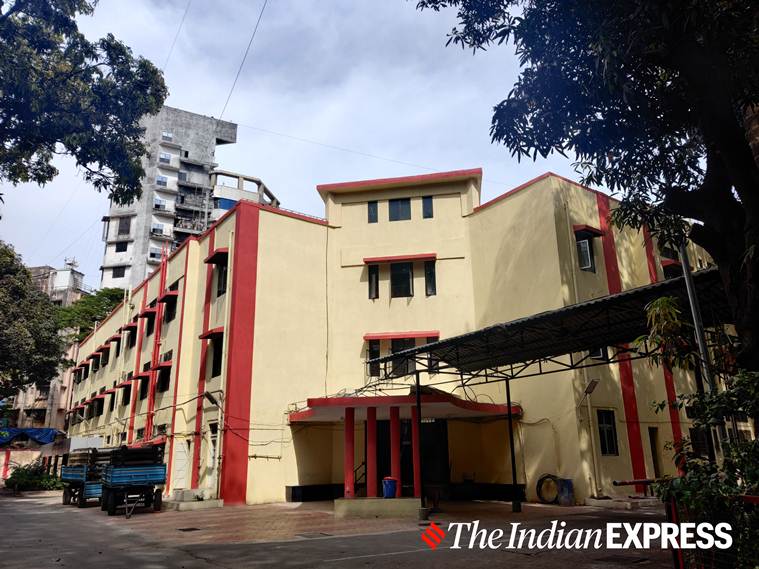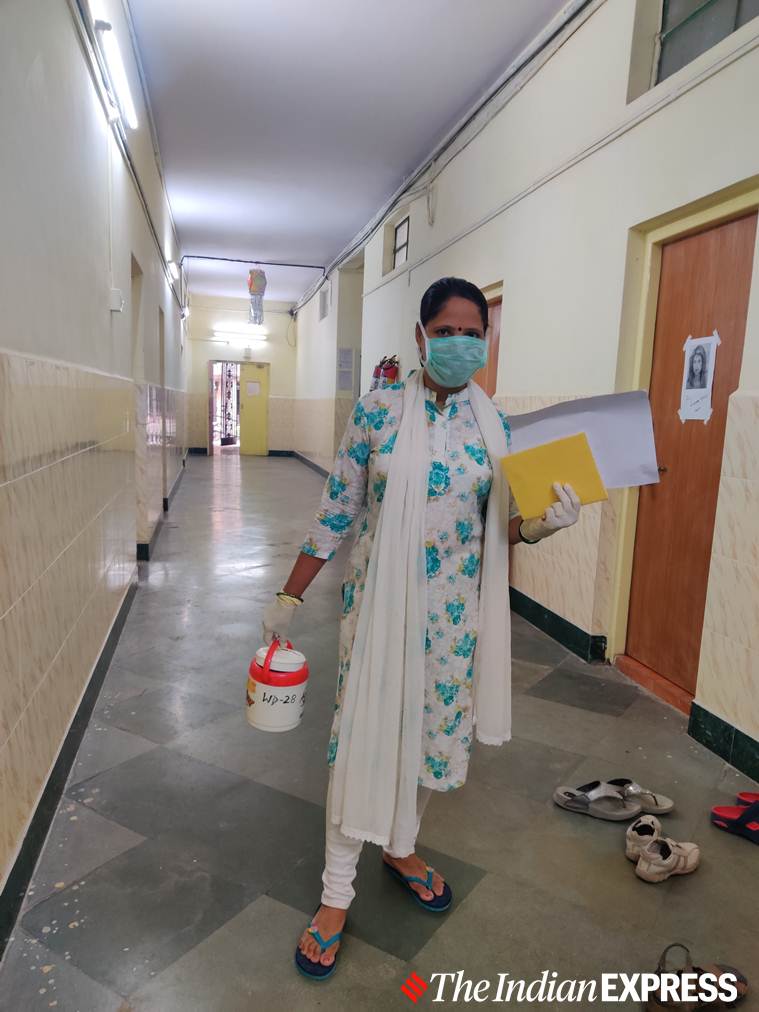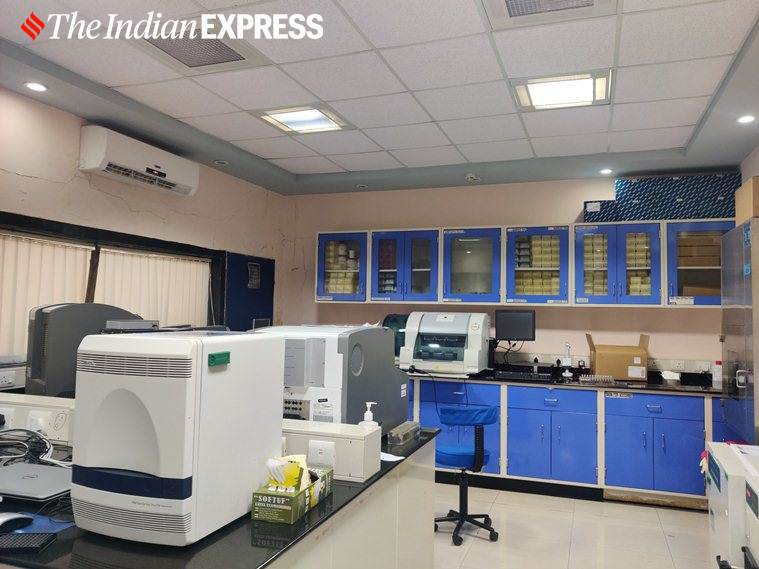Stay updated with the latest - Click here to follow us on Instagram
Coronavirus outbreak: At Ground Zero, 12 doctors, double the nurses at work
It was early January when Dr Chandrakant Pawar, superintendent of Kasturba Hospital the nodal facility for diagnosing and treating COVID-19 in Mumbai started preparing for the outbreak because China, he says, is “dangerously close”.
 Medical staff wear masks amid concerns of COVID-19 spread at Kasturba Hospital in Mumbai on Friday. (Photo by Prashant Nadkar)
Medical staff wear masks amid concerns of COVID-19 spread at Kasturba Hospital in Mumbai on Friday. (Photo by Prashant Nadkar)
“Anybody but doctors can work from home,” smiles Dr Jayanthi Shastri, head of BMC-run Kasturba Hospital’s laboratory, where each day over 60 samples are being tested. Within its walls, the quite laboratory has managed to shut out the panic the highly transmissible virus has caused in public, with everyone continuing to do their assigned tasks in an orderly way.
It was early January when Dr Chandrakant Pawar, superintendent of Kasturba Hospital the nodal facility for diagnosing and treating COVID-19 in Mumbai started preparing for the outbreak because China, he says, is “dangerously close”.
He first stocked N-95 masks and protective gears for his staff. There are 12 doctors, 24 nurses and equal number of class IV employees deputed to look after the isolation facility a yellow-colored building that stands alone in a leafy corner of the vast hospital premises.
 The isolation facility in Kasturba Hospital. (Express Photo: Tabassum Barnagarwala)
The isolation facility in Kasturba Hospital. (Express Photo: Tabassum Barnagarwala)
The first isolation beds were set up in 2002 when Severe Acute Respiratory Syndrome, also a coronavirus, epidemic broke in China. Slowly, the ward grew to accommodate 10 beds.
Last month, its strength touched 28. Today, there are 58 beds in the building from first to third floor. “Fifty more can be added at short notice,” Additional Municipal Commissioner Suresh Kakani said. The hospital is set to appoint six more doctors soon.
Following the COVID-19 pandemic, any traveller from abroad suspecting to be infected first visits ward 9, where four doctors are deputed. Immediately, they are handed a mask. Then, based on their travel history and symptoms, they are categorised as symptomatic, asymptomatic and high risk or suspected. The symptomatic and suspected cases (those in close contact of infected people) are admitted in ward 30 in the yellow-coloured building. Their nasal or throat swab is taken, and stored in a thermos-like box called vaccine carrier. The nurse takes it to ground floor where the laboratory is located.
 A staffer comes with a sample stored in vaccine carrier. (Express Photo: Tabassum Barnagarwala)
A staffer comes with a sample stored in vaccine carrier. (Express Photo: Tabassum Barnagarwala)
A young class IV cleaner, who has been posted to isolation ward three months ago, says her family panics and asks her to remain at a foot’s distance from patients. “I try to not enter the isolation ward unless necessary. When I enter, I wear the protective gear and clean the entire area. I leave no task behind so that I don’t have to re-enter,” she says.
Another class IV cleaner has worked in the hospital for 25 years, and remains composed. “I have done this for so many years, I know the drill. There is nothing to worry if we follow all rules,” she says. Carrying the vaccine carrier is like carrying her lunch box, she smiles, as she sees another nurse bring fresh nasal samples to the laboratory.
The BMC laboratory, started in 2007, has its genesis in the 2005 deluge. “Our Chief Minister Uddhav Thackerayji said at that time (he was not CM then) why should we send our leptospirosis samples to Andaman and Nicobar Island for testing. We should have a laboratory here. And Rs 4 crore was sanctioned by (Shiv Sena-controlled) BMC ,” Shastri says.
 Travellers from abroad leave from Ward 9 of Kasturba Hospital where preliminary assessment is done to check symptoms and record travel history. (Express Photo: Tabassum Barnagarwala)
Travellers from abroad leave from Ward 9 of Kasturba Hospital where preliminary assessment is done to check symptoms and record travel history. (Express Photo: Tabassum Barnagarwala)
Six persons work in two eight-hour shifts to test samples round the clock. More skilled personnel are needed, and the laboratory has borrowed technicians from regional HIV reference lab. Currently, the laboratory has one scientific officer, three technicians, a research scientist, and assistant scientist. They are prepping to work for 24 hours if the situation worsens.
In 2015, a real-time polymerase chain reaction (PCR) machine was installed. That is now being use to test samples within three hours. In a 200 square feet spotless room, a large microwave-machine like device mixes the reagents. The sample is then put in an extraction machine where the RNA (Ribonucleic Acid) from swab is extracted over the next one hour. This is then fed into an amplification machine. The portable device looks like a printer, but does the most important job — it amplifies the virus in the sample so that the machine can detect it easily. The result comes in the form of an upward shooting graph.
With the number of samples increasing each day, the laboratory cannot afford to get a run-to-fail (false reading) sample. On March 11, a “VIP sample” referred by the municipal commissioner was undergoing a test when there was a powercut. Amid frantic calls, the laboratory re-started the test. Now, they are fitting a generator to avoid power cuts to the machine.
The staffers claim that during H1N1 pandemic in 2009, the panic was widespread in the hospital but not tangible on the streets. This time, they say, the trend has reversed.
 The laboratory room at Kasturba Hospital where tests are carried out on real-time PCR machine. (Express Photo: Tabassum Barnagarwala)
The laboratory room at Kasturba Hospital where tests are carried out on real-time PCR machine. (Express Photo: Tabassum Barnagarwala)
Each nurse and staffer knows the drill. When a patient tests positive, they are given symptomatic treatment for cough, cold and pneumonia and tested every alternate day. Their urine, stool and blood samples are sent to National Institute of Virology in Pune to assess the viral shedding process — by what amount is the virus being shed from the infected body. If two tests come negative in a gap of 24 hours, the patient is discharged. The virus has been cleared from his body. With three positive cases in Mumbai and one in Thane, such a discharge is yet to happen.
When a patient tests negative, they are next tested for H1N1 as precaution, and shifted to a second ward away from positive cases. Eventually, they are discharged. Suspected cases are kept in an entirely different ward.
Superintendent Pawar, who has worked in the hospital all his life, says he has not managed to sleep beyond four hours a night since the outbreak. Sometimes, the airport authority calls in the middle of the night to send a patient and he has to make calls for arrangements. On Thursday night, he could not even go home. “But I would not trade this job for anything else. This work is for public good.”







